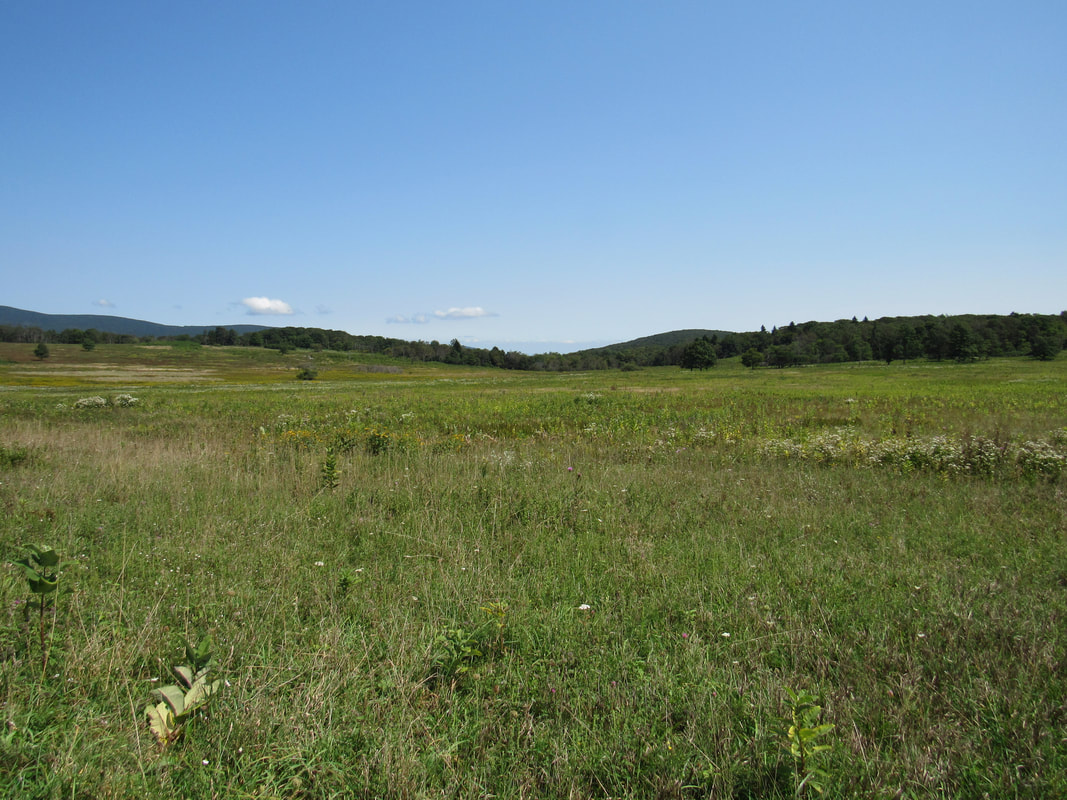| Snakeroot is one of the last flowers to bloom in summer, and though it is beautiful to see, the flower contains a toxin called tremetol. In the 1800s, many people (including Abraham Lincoln's mother) died from a mysterious disease that was ultimately traced to the toxin of the Snakeroot. Evidently, cows would consume the flowers, and the toxin would contaminate their milk (and then, ultimately, butter and other dairy products). Check out the photos below, left & right, to see our flowery encounter. This was in the green of the year, but it sure looked like a winter wonderland. | By Emily Dickinson: This was in the White of the Year – That – was in the Green – Drifts were as difficult then to think As Daisies now to be seen – Looking back is best that is left Or if it be – before – Retrospection is Prospect's half, Sometimes, almost more. |
| | |
Below right: The spider species Argiope aurantia is commonly known as the yellow garden spider, black and yellow garden spider, golden garden spider, writing spider, banana spider, zigzag spider, hay spider, corn spider, Steeler spider, or McKinley spider.
| By Emily Dickinson: Alone and in a Circumstance Reluctant to be told A spider on my reticence Assiduously crawled And so much more at Home than I Immediately grew I felt myself a visitor And hurriedly withdrew. | |
Surcingles? What in the world is a "surcingle"? I have to admit -- I had to look that one up -- and when I did, I concluded that Dickinson wasn't being purposefully obscure. Instead, I realized that the average person in the 19th century would have known the meaning of "surcingle."
SURCINGLE: a wide strap that runs over the back and under the belly of a horse, used to keep a blanket or other equipment in place.
| | By Emily Dickinson: Bees are Black, with Gilt Surcingles – Buccaneers of Buzz. Ride abroad in ostentation And subsist on Fuzz. Fuzz ordained – not Fuzz contingent – Marrows of the Hill. Jugs – a Universe's fracture Could not jar or spill. |
From the National Park Service's site on Shenandoah (HERE): "In the 1930s, Shenandoah National Park was pieced together from over 3,000 individual tracts of land, purchased or condemned by the Commonwealth of Virginia and presented to the Federal Government. In the process, at least 500 families -described as 'almost completely cut off from the current of American life' were displaced in what was considered by some to be an humanitarian act."
Other sites describe the relocation of displaced families in much more poignant terms:
From a story on Richmond.com: Harvey Shifflet's family "was among the hundreds of families forced from their homes in the 1930s to make way for Shenandoah National Park as state authorities used eminent domain to acquire private property that would be turned over to the federal government for the park. After leaving Rockingham in 1933, the Shiffletts settled in the foothills of Albemarle County, but Harvey Shifflett’s heart never relocated.
Decades later, still bitter at the way his family had been treated and still longing for his mountain home, he would have his children drive him to the park on weekend mornings where he would sit for hours on one of the stone walls along Skyline Drive — not far from his old home place. The old man spent the time whittling, watching the tourists drive by and soaking in the beauty that once was his."
The complete article is HERE.
Testament to the stories of displaced families, there are family cemeteries found throughout the park. Below: We came across the Dean family cemetery nestled in the forest near Milestone 63. The land once belonged to James Dean (no, not that James Dean), who lived from 1797 until 1862.
| By Emily Dickinson: I see thee clearer for the Grave That took thy face between No Mirror could illumine thee Like that impassive stone -- I know thee better for the Act That made thee first unknown The stature of the empty nest Attests the Bird that's gone. | |
Below: Miscellaneous pics from the park.
| | |
| | |





 RSS Feed
RSS Feed
